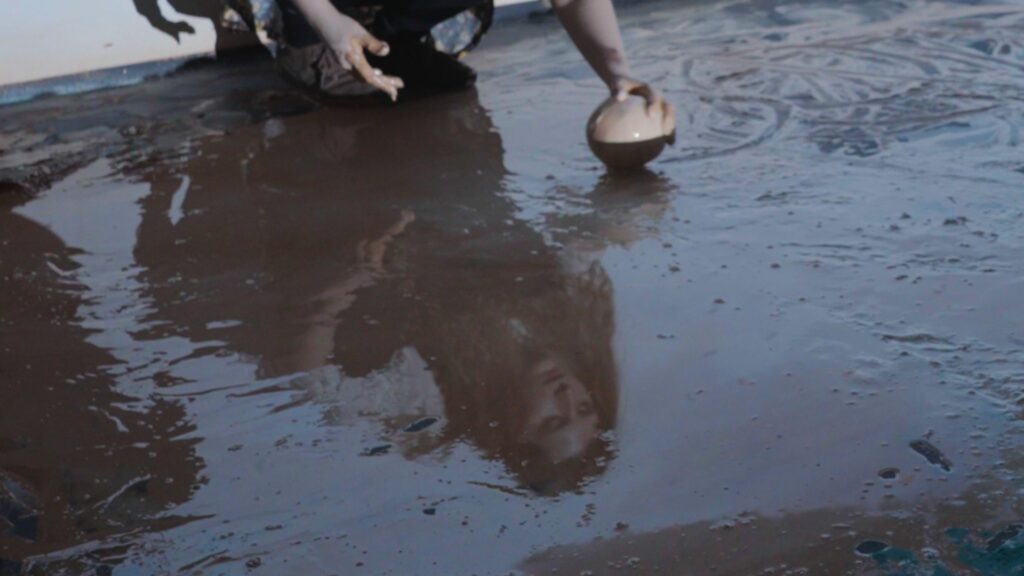Performance: Stefania Crisan – Reverse the Entropy
29 July – 7 pm
Performance: Stefania Crisan – Reverse the Entropy
29 July – 7 pm
Location: 29 Băiculești Street, Bucharest
Organizer: Sector 1 Gallery
We are very pleased to invite you at the gallery for the performance “Reverse the Entropy” by artist Ștefania Crișan. The event will take place on Saturday, July 29th, from 19:00, at Băiculești 29, Bucharest.
Following the performance, we invite you to an artist talk presented by Ștefania Crișan, moderated by Cristina Bută.
“On the skin of the world there are clues. Colours that change afterwards. Asperities and strange alchemies. Tears and cuts, blisters and burns. Skin marked with a branding iron. Stefania Crișan walks on this skin. Barefoot. She walks slowly, often stops, kneels down, lays her hands on the ground, approaches her mouth, presses her ear against it. She feels the vibrations, hears the rumblings, listens to the pulsations. She knows that she is walking on eggshells. That these eggs contain creatures that are already alive, not yet born, monstrous-looking because they haven’t yet reached their final appearance. She walks on quicksand and knows that on the other side, the world below cries out in silence. Lying on her stomach, she becomes one with it, absorbs, receives the waves, and, motionless, samples fragments, collects them, deciphers them, translates them. She stays there for a long while. When she gets up, she remains silent. Then she sings.”
__Excerpt from Célia Charvet, CHUT.E. CHANT. SON. Ștefania Crișan against the skin of the world in LEAP – the Luxembourg Encouragement for Artists Prize catalogue, 2022.
Geamăna is a project of poetic activism comprising several works. In 2017, Ștefania Crișan discovered the existence of Geamăna, a Romanian village submerged under the toxic waters of a settling lake. In the late 1970s, Nicolae Ceaușescu’s regime sacrificed this village at the foot of the Western Carpathian Mountains in order to exploit the copper mines of Roșia Poieni, forcing 365 families to leave. Today, the mining of copper and other metals in the gutted mountains of Roșia Poieni is causing an ecological disaster that extends over more than 130 hectares, with nearly 27 million tons of waste deposited in the lake every year. The only trace of the presence of the former village, the roof of the church, a symbol of the sacred, emerges from the water, which has turned orange due to the presence of cyanide. It acts as a ‘vestige of the future’ and a warning. Despite the tragic fate of their village, the local residents have never ceased to believe in God and in spirituality. Crișan collected images, objects and testimonies from the site and, through a sensitive understanding, translated them back into performances, installations, sculptures or intuitive chantings.
The performance “Reverse the Entropy”, in dialogue with the video installation “Geamăna”, was created after the artist’s first encounter with the landscape of Geamăna in 2017. At the time, she met two women living close to the contaminated lake. Despite their own sufferings, they offered her water, a place to sleep and their blessings. When the artist returned in 2018, she learned that one of the women had died. The performative sculpture Ophelia and the Anthropocene is a ‘portrait-receptacle’, a reflection on death, the disappearance and transformation of matter – in tribute to the deceased woman.
Performers: Ștefania Crișan & Victor Mopin
Ștefania Crișan (b. 1993, Romania) is interested in themes connected to the Anthropocene, questioning the paradoxes between the horror and the beauty of catastrophe, between observing the impossible inversion of the entropy and the healing virtues of ritual practices; between the death of a landscape and the death of painting. She is the winner of the 2022 Luxembourg Encouragement for Artists Prize (LEAP) and has exhibited at FRAC Lorraine, Casino Luxembourg, Stadtgalerie Saarbrücken and Centre Pompidou-Metz. She lives and works in Metz, France.
The performance is part of the exhibition Mother’s Nature, curated by Maya Økland and Cristina Bută.
Looking for more?
Address
Băiculești 29 Street, District 1, 013193, Bucharest, Romania
Opening Hours
Tuesday – Saturday, 2 – 7 PM
Sunday – Monday, by appointment only
Newsletter
Sign up to receive the latest news on the gallery’s artists
Sector 1 Gallery © 2023. All Rights Reserved.
Privacy Policy

